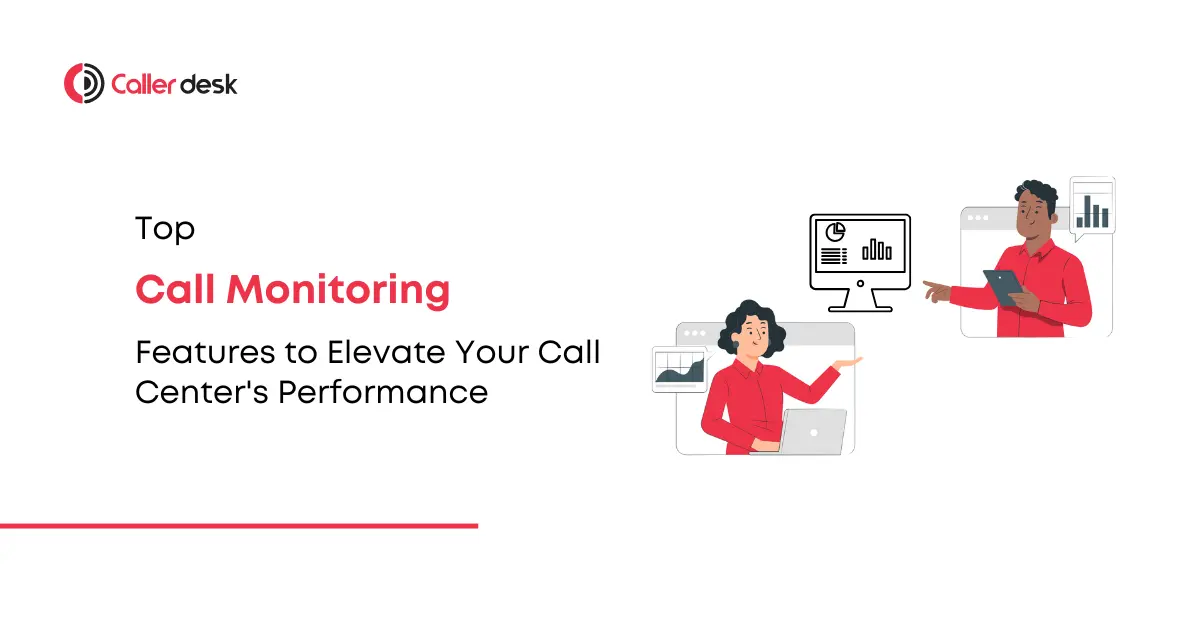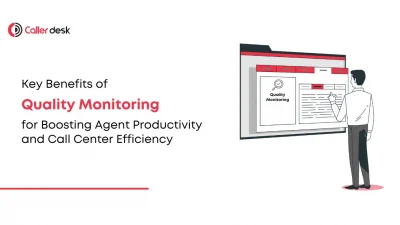Did you know that 96% of customers believe customer service plays a crucial role in brand loyalty? One great customer experience can make someone a lifelong advocate of your brand, while a poor one could lose their trust forever.
Managing a call center isn’t just about answering calls quickly—it’s about building trust and delivering exceptional customer service at every touchpoint. To achieve this, businesses must go beyond traditional metrics and invest in Call Quality Monitoring (CQM).
Call monitoring is the cornerstone of operational excellence in modern call centers. It ensures agents deliver exceptional service, adhere to compliance standards, and meet customer expectations consistently. By leveraging cutting-edge call monitoring features, such as call whispering, call analytics, and real-time guidance, call centers can refine their operations, empower their agents, and elevate the customer experience.
In this blog, we’ll take a deep dive into essential call monitoring features that can significantly improve your call center’s performance, reduce inefficiencies, and drive customer satisfaction.
The Importance of Call Monitoring in Call Centers
Call monitoring goes beyond simply listening to conversations between agents and customers. It’s about:
- Identifying Trends: Understanding customer pain points and frequently asked questions.
- Agent Development: Providing targeted feedback to help agents improve their communication, empathy, and problem-solving skills.
- Compliance: Ensuring agents adhere to industry regulations and company policies.
- Improving Customer Satisfaction: Ensuring every customer feels heard, respected, and valued.
With the right tools and strategies, call monitoring can be the catalyst for delivering world-class customer service.
Key Call Monitoring Features to Revolutionize Your Call Center
1. Call Whispering: Empower Agents in Real-Time
Call whispering is a powerful feature that allows supervisors to listen in on live calls and provide real-time guidance to agents—without the customer knowing.
How It Works:
- Supervisors silently join the call and offer suggestions to agents during the conversation.
- Agents benefit from real-time coaching, boosting their confidence and helping them deliver better responses.
Why It Matters:
- Improves on-the-job training for agents, especially new hires.
- Ensures immediate support for handling complex queries or challenging customers.
CallerDesk Integration:
With CallerDesk’s call whispering tool, supervisors can provide unobtrusive assistance, helping agents navigate tricky situations and meet customer expectations without disrupting the flow of the conversation.
2. Call Barging: Handle Escalations with Confidence
Call barging allows supervisors to join a live call and speak directly to both the customer and the agent.
Best Use Cases:
- Handling high-stakes escalations, such as complaints from VIP customers.
- Intervening in cases where the agent is unable to resolve the issue independently.
Example:
A long-time customer is frustrated with repeated billing issues and requests immediate managerial attention. With call barging, supervisors can directly address the customer’s concerns, resolving the issue efficiently and restoring trust.
CallerDesk’s Edge:
CallerDesk’s call barging feature enables seamless transitions during escalations, ensuring both customers and agents feel supported during high-pressure situations.
3. Call Analytics: Leverage Data for Smarter Decisions
Call analytics is essential for gaining actionable insights into agent performance and customer sentiment.
What It Offers:
- Evaluates key factors like tone, sentiment, adherence to scripts, and resolution effectiveness.
- Tracks metrics such as call duration, hold time, and first-call resolution rates.
Why It’s Essential:
- Helps identify recurring customer pain points, allowing managers to implement proactive solutions.
- Supports targeted training by highlighting agent strengths and weaknesses.
CallerDesk’s Advanced Analytics:
With CallerDesk’s AI-driven analytics, managers can uncover trends, predict customer churn, and continuously optimize agent performance.
4. Real-Time Guidance: Immediate Course Corrections
Real-time guidance ensures agents stay aligned with best practices and compliance protocols during live calls.
How It Works:
- AI tools offer live prompts, reminding agents about key points, such as upselling opportunities or compliance requirements.
- Supervisors can intervene and provide guidance during calls when agents face challenges.
Example Applications:
- A supervisor notices an agent forgetting to upsell a promotional offer and prompts them in real-time to include it in the conversation.
- AI tools remind agents of compliance protocols during sensitive customer interactions, ensuring error-free service delivery.
CallerDesk’s Real-Time Tools:
With CallerDesk’s real-time monitoring capabilities, supervisors can step in at the right moment to guide agents, boosting both performance and confidence.
5. Automatic Call Scoring: Streamline Evaluations
Manual evaluations are time-consuming and prone to bias. Automatic call scoring simplifies the process by evaluating each call against pre-defined criteria.
Key Benefits:
- Identifies top-performing agents who can be recognized or used as mentors.
- Pinpoints areas where agents need improvement, streamlining training efforts.
CallerDesk’s Call Scoring Feature:
CallerDesk’s automatic call scoring assigns quality scores to calls based on empathy, adherence to protocols, and resolution accuracy, enabling efficient and fair performance evaluations.
Advanced Features to Elevate Call Monitoring
Speech Analytics for Customer Insights
CallerDesk’s speech analytics feature goes beyond basic monitoring, using NLP (Natural Language Processing) to detect customer emotions and predict potential dissatisfaction.
Example Use Case:
Speech analytics identifies frequent complaints about delayed deliveries, prompting the operations team to adjust logistics processes for improved efficiency.
Customer Feedback Collection
Collecting direct feedback through post-call surveys ensures that your service improvements align with customer expectations.
CallerDesk’s Solution:
CallerDesk’s automated feedback collection tools simplify this process, making it easy to gather actionable insights.
How to Select the Best Quality Monitoring Tools
Selecting the right monitoring tool is crucial for achieving your operational goals. Here’s how to make the best choice:
- Identify Core Needs:
Focus on features that align with your business goals, such as real-time monitoring or AI-driven analytics. - Evaluate Scalability:
Choose software like CallerDesk that can grow with your business, handling increased call volumes seamlessly. - Prioritize User Experience:
Opt for intuitive tools with a simple learning curve to maximize adoption among agents and supervisors. - Test the Software:
Take advantage of CallerDesk’s free demo to assess its features in real-world scenarios.
Why Choose CallerDesk?
CallerDesk stands out with:
- AI-Powered Analytics: Advanced tools for speech and sentiment analysis.
- Seamless Integrations: Compatibility with top CRM platforms to streamline workflows.
- Comprehensive Dashboards: Real-time visibility into agent performance and customer satisfaction.
- Flexible Scalability: Plans that grow with your business, ensuring long-term value.
Conclusion
Incorporating essential call monitoring features like call whispering, call analytics, and real-time guidance isn’t just about optimizing operations—it’s about creating lasting customer relationships. By investing in cutting-edge tools like CallerDesk, your call center can achieve new heights of efficiency and service quality.
Ready to transform your call center? Schedule a free demo with CallerDesk today and experience the difference firsthand!
Frequently Asked Question
1. What are call monitoring features in a call center?
Call monitoring features in a call center are tools and functionalities designed to evaluate, analyze, and enhance the quality of customer-agent interactions. Examples include call whispering, call analytics, real-time guidance, and automatic call scoring. These features improve agent performance and ensure exceptional customer service.
3. How does call analytics benefit call center performance?
Call analytics evaluates key aspects of customer calls, such as tone, script adherence, and resolution accuracy. It identifies trends, highlights agent strengths and weaknesses, and provides actionable insights to improve agent training and enhance customer satisfaction.
4. What is real-time guidance, and how does it work?
Real-time guidance provides supervisors or AI tools the ability to give agents live feedback or prompts during customer calls. For example, it reminds agents about compliance protocols, script adherence, or upsell opportunities, ensuring calls stay on track without waiting for post-call evaluations.
5. How do I choose the best quality monitoring software for my call center?
To choose the right software:
Identify your specific needs (e.g., real-time monitoring, analytics, or scalability).
Test software with a demo to ensure it aligns with your goals.
Prioritize tools that integrate seamlessly with your existing systems.
Look for features like AI-powered analytics, call scoring, and compliance management.
6. Can call monitoring tools help with agent training?
Yes, call monitoring tools like call whispering and real-time analytics are excellent for training. They allow supervisors to provide immediate feedback and guidance during calls, identify skill gaps, and create customized training programs to improve agent performance.
7. What is automatic call scoring, and why is it useful?
Automatic call scoring assigns a quality score to calls based on predefined criteria like empathy, resolution accuracy, and protocol adherence. It helps supervisors identify top performers, streamline evaluations, and offer targeted coaching to agents needing improvement.
8. How does speech analytics enhance customer satisfaction?
Speech analytics uses AI and natural language processing (NLP) to detect customer sentiment, emotions, and tone during calls. It helps identify dissatisfied customers, resolve issues proactively, and refine service strategies to ensure a positive experience.
9. Is call monitoring compliant with data privacy laws?
Most modern call monitoring tools, including CallerDesk, comply with data privacy laws like GDPR. They ensure call recordings and data are stored securely and are accessible only to authorized personnel for quality evaluations. Always choose software that meets regulatory standards.
10. Why should I consider CallerDesk for call monitoring?
CallerDesk offers cutting-edge features like AI-powered analytics, real-time guidance, seamless CRM integrations, and intuitive dashboards. It ensures better agent performance, customer satisfaction, and scalability for growing businesses, making it an excellent choice for call centers.





